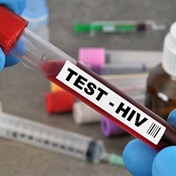A study has found that about 55% of HIV patients in South Africa who are not eligible for treatment at the time of diagnosis will disappear from clinics within a year of initial monitoring, leaving a serious gap in HIV care and prevention, say researchers.
Most patients in South Africa must have a CD4 count - a measure of the immune system's strength - of 200 or less to be eligible for antiretrovirals (ARVs), but previous research has shown that about two-thirds of people will not meet ARV treatment criteria at diagnosis.
High loss-to-follow-up rate
Published in the journal Aids, the study examined about a year's worth of CD4 laboratory records for 4,223 HIV patients in South Africa's KwaZulu-Natal province who were not eligible for ARVs. Conducted by the Africa Centre for Health and Population Studies at South Africa's University of KwaZulu-Natal, the research found high loss-to-follow-up rates and that patients diagnosed HIV-positive at higher CD4 counts, and who were younger and male, were more likely not to return for CD4 count tests at the recommended six month intervals.
The study also noted that among patients who remained in clinic's outpatient care, the majority returned only once for CD4 monitoring and that their CD4 counts dropped much more quickly than previous South African research has suggested. CD4 level counts dropped by an average of about nine cells per month. However, patients with higher CD4 counts, who were also less likely to adhere to CD4 monitoring, saw drops as much as twice that.
Limited resources
While the study did not include qualitative data on patients' reasons for discontinuing care, lead author Richard Lessells said the limited medical services available to pre-ARV patients may be partly to blame.
While patients like these can access drugs such as bactrim and co-trimoxazole for opportunistic infections, Lessells said that if patients are sick enough for these drugs, they are usually sick enough to qualify for ARVs.
"As a doctor the most frustrating thing is seeing a patient return with opportunistic infections and finding out that they were diagnosed two years previously with a CD4 count of 300 but had been lost to the system. Now they are presenting sick and require hospital care," he told IRIN/PlusNews. "It's frustrating to know that, in theory, this is preventable."
For Lessells, the study highlights a patient population that has been sidelined in the rush to get those who are eligible on ARVs.
"These patients certainly aren't the priority," he told IRIN/PlusNews. "The clinics are already overcapacity just dealing with patients ARVs so there's very little scope or time even for people who are not in that category."
Neglected but important
With priorities elsewhere, he added that most programmes and the South African Department of Health do not collect data on pre-ARV patients or their access to care, but that these patients represent a key entry point for initiatives looking to reduce Aids-related mortality and new HIV infections.
With an estimated HIV prevalence of about 18%, South Africa currently runs the world's largest ARV programme with more than one million patients on treatment. In an effort to get more patients on treatment earlier and bolster behavior change, the government is in the midst of a national campaign to voluntarily test 15 million South Africans for HIV by April 2011.
But Lessells cautioned that the high loss-to-follow up of pre-ARV patients jeopardises these goals.
"The whole point of this testing campaign is to try and get as many people to know their status as possible, based on the assumption that people will change their behaviour, but we need to make sure that there are programmes supporting people, and giving them appropriate care and education about prevention," he said. "There's a lot of literature out there about the integration of HIV care and prevention, but at a practical level, this isn't happening."
Research needed to inform programme design
While a smaller, Johannesburg-based study published last year in the journal of Tropical Medicine and International Health confirmed high pre-ARV loss-to-follow-up, Lessells said more research was needed into this group, including what programmes could provide in terms of incentives.
And figuring out what keeps pre-ARV patients away, may mean rethinking programmes.
"[Researchers, programme managers] are always looking at what it is about the patients that makes them not come back; there's always this sense that the patient is to blame," he told IRIN/PlusNews. "We need to get over that and start thinking what it is about our programmes that are not encouraging people to stay."
While many studies have shown that the farther patients must travel to a clinic, the less likely they are to return, Lessells' study found that retention was low despite the fact that about 90% of the study population lived within 5km of the nearest clinic.
As government continues to push for the roll-out of isoniazid preventative (IPT) tuberculosis therapy among all HIV patients, Lessells said he hoped research was being undertaken to ascertain whether the addition of this service would provide the kind of incentive needed to retain patients or whether the added stress on clinics and pharmacies would become yet another disincentive to staying in care. - (PlusNews, February 2011)
Read more:
HIV - not a death sentence
Basic management and monitoring of HIV infection




 Publications
Publications
 Partners
Partners










